207 SQUADRON ROYAL AIR FORCE HISTORY
Wall Crew, Holtzwihr, Alsace, France
Lancaster I - PB765 EM-B
website by207 Squadron Royal Air Force History
4th December 1944
The Squadron History records that "207 Squadron crews reported their first sighting of enemy jet fighter aircraft, an Me 262, during a raid by 19 aircraft on Heilbronn railway yards, but no combats took place. This was regarded as a successful raid although two Lancasters, captained by P/O G L Wall (PB765 EM-B) and F/O M J Lovett (LL968 EM-K) failed to return and those that did experienced nasty electrical storms on the way home".
From Bill Chorley's Bomber Command Losses of the Second World War, in the volume for 1944, and from Squadron records, shows the missing crew of PB765 as:
4-5 Dec 1944 207 Sqn - Lancaster I - PB765 EM-B
| F/O George Lawlor Wall RAAF |
Pilot |
POW |
|
| Sgt Eric Floyd Dunn RAF(VR) |
F/E |
POW |
|
| P/O Arthur Henry Clarke RAAF |
Nav |
NKG, age 31 |
Runnymede Air Forces Memorial |
| P/O Roy Ernest Hill RAF(VR) |
W/Op |
POW |
|
| P/O William Henry Wulff RAAF |
B/A |
POW |
|
| F/S Edward Sharp RAF(VR) |
M/U |
KIA, age 39 |
Choloy War Cemetery, France |
| Sgt William Francis Turner RAF(VR) |
R/G |
KIA, age 39 |
Choloy War Cemetery, France |
|
| Bill's book, published in 1997, reflects the official
records and how the survivors thought they came to be shot
down:
"t/o 1637 Spilsby. Hit by flak, shrapnel from the blast slicing into the central fuselage and mortally wounding Sgt Sharp. Partially abandoned and crashed near Holtzwihr (Haut Rhin), 6km NE from the centre of Colmar. It is thought P/O Clarke RAAF left the aircraft but his body was never found. His name is perpetuated on panel 258 of the Runnymede Memorial, while both air gunners are buried in France at Choloy War Cemetery." Google Maps - Holtzwihr |
 |
HoltzwihrOn 27th January 1985, during the celebrations of the 40th anniversary of the liberation of Holtzwihr, Patrick Baumann and Joseph Barthelemy became fascinated by the stories told by the older villagers about the wartime years. In particular, just before the village was devastated in the battles between the US 3rd Infantry and the Wehrmacht, a large aeroplane, blazing like a meteor, had narrowly missed the village. This set in train years of patient research, with the first clue being the finding of a small piece of wreckage that was indisputably British. Eventually the two researchers identified that the aircraft was PB765 of 207 Squadron. It was discovered that two bodies had been removed from the aircraft wreckage - the aircraft was lost on the return to base, having bombed on target. The two gunners were interred in the village churchyard, following a brief service by the local priest, which the Germans forbade villagers to attend. After the war the gunners were re-interred in Choloy War Cemetery. An advertisement in RAFA's Air Mail in 1988 yielded a response from Ron Winton ISM, then Membership Secretary of 207 Squadron RAF Association. Roy Hill had known Ron, a fellow Wireless Operator, both at Spilsby and as a POW in Stalag Luft I, Barth. This eventually lead to Roy Hill being put into contact with the Holtzwihr researchers. Through the 207 Sqn RAF Association George Wall in Australia was then found. As it was known that Artie Clarke's body had never been been found, that left Bill Wulff and Eric Dunn to be located. Eric was found in Dawlish, Devon, as the result of an appeal on Cilla Black's popular Searchline Special tv programme. George Wall eventually tracked Bill Wulff down to Bateman's Bay in New South Wales. |
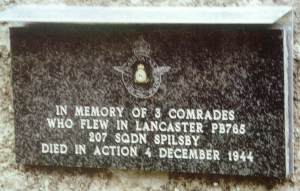 Plaque in Holtzwihr Churchyard, donated by Eric Dunn's mother, commemorating where Sgt Turner and F/Sgt Sharp were originally laid to rest. 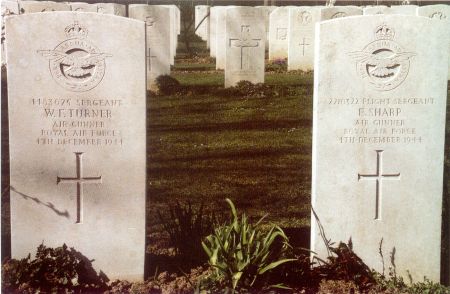 Winky Turner and Ted Sharp side by side in Choloy War Cemetery, Meurthe-et-Moselle: Artie Clarke has no known grave and is commemorated on panel 258 of the Runnymede Air Force Memorial. |
| Roy and Eric visited Holtzwihr in 1989 and were
interviewed by the local tv channel at the crash site.
Plans were set in motion for a return in 1990, for the 45th anniversary of Holtzwihr's liberation. These photos were taken on later visits. |
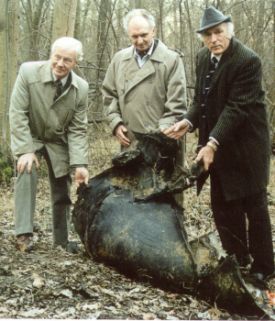 L-R : Roy Hill, Eric Dunn and George Wall finding parts of PB765 at the crash site: a large chunk of rubber, presumably from one of the main wheel tyres |
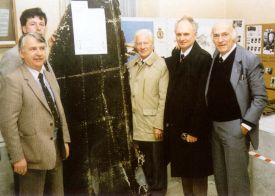 L-R : Researchers Joseph Barthelelmy, Patrick Baumann , with crew members Roy Hill, Eric Dunn and George Wall - and the largest piece of PB765 found so far, a wing tip section. |
1990The Village very generously made it possible for Roy Hill, Eric Dunn and George Wall and their wives to attend the 45th Anniversary of the Liberation of Holtzwihr, culminating in the unveiling of two memorials to the crew on January 27th 1945. Bill Wulff was not well enough to attend from Australia. In his dedication speech for the plaque on the Village Hall, the Mayor said: "45 years have passed since the liberation of Holtzwihr." "Our village was not spared the ravages of war. 90% of it was destroyed and 33 people both civilians and military, were killed; their names are engraved on our War Memorial. The scars of many wounds and much suffering run deep, so that the memory does not fade." "December 1944: the fight against Nazi Germany intensified. Almost every night Allied bombers flew across our skies in order to reach the enemy's targets. One of these aircraft was hit by German flak and crashed in the woods near Holtzwihr. Thanks to patient and thorough research by two of our community, Patrick Baumann and Joseph Barthelemy, today we are able to welcome three of the surviving crew of this aircraft: the British, Roy Hill and Eric Dunn as well as the Australian George Wall." |
 Commemorative bronze plaque on the Village Hall, Holtzwihr |
"On behalf of the people of Holtzwihr, of the village council and myself, I would like to honour them as well as their British friends, William Turner, Edward Sharp and A.H. Clarke, and specially thank them on the occasion of this anniversary ceremony."
"Our thoughts and gratitude also go to all those who fought and gave their lives to free our village and our country, France, so that peace and democracy live on. Current world events show to those nations who have paid the cost that these values are eternal." Pierre Fuchs, Mayor of Holtzwihr
The occasion was also marked by parades and presentations, followed by traditional French hospitality, all the better for the local wines. Later in the day, the forest at the crash site was cold and forbidding, but the simple stone memorial evoked memories of those who gave their lives. The walk to the memorial from the village has over the years become popular and Roy and his wife Gill have provided bulbs of typical English flowers to bring a touch of home.
In the 1990 207 Squadron Association Newsletter, the then President AVM David Dick reported : "In January of this year, the town of Holtzwihr in France, commemorated the 45th anniversary of the liberation of their town. They have taken as the symbol of their liberation the crash of Lancaster EM-B (PB765) on the night of 4th December 1944, in which three crew members were killed, two of whom are buried in Holtzwihr. One crew member has no known grave, and four survived, including the Captain, G Wall, from Australia, and our member RE Hill, who was the Wireless Operator, and E Dunn. Ron Winton, the Membership Secretary had reunited them all by letter. G Wall came over from Australia for the event, and RE Hill and Eric Dunn both attended, with their wives: sadly, the fourth surviving crew member E Wulff, also from Australia, was not well enough to travel. Mrs Hill tells me that this ceremony was also very moving , extremely well organised, and was clearly regarded by the townspeople as being of great significance. The local 'MP' and an official from 'Le Departement' also attended. The bodies of two crew were found in the wreckage: the visitors were introduced to the two ladies, who as young girls, had witnessed the parish priest wrapping the bodies in their parachutes prior to burying them. The girls had then been discovered by the Germans and were hastened away.
In 1995 Roy and Gill Hill returned at the invitation of the village for the momentous 50th Anniversary of Liberation, accompanied by a team from Central TV. There was also a much larger celebration at Marcolsheim, attended by thousands from the local villages, which paid homage to the American forces who liberated them.
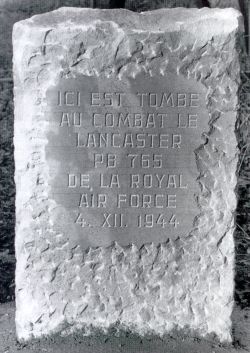 The crash site memorial |
 45th Anniversary Holtzwihr postcard produced at the time of the dedication of the memorials. |
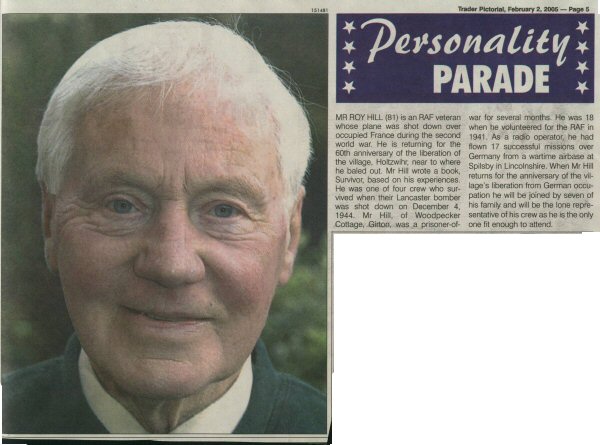
Roy Hill plans to return, 2004
Schräge Musik
In December 1990 Patrick Baumann's brother Marc, who had made contact with German nightfighter squadron associations and researchers, contacted Roy Hill to say that he had found evidence that PB765 was not shot down by flak but by a night fighter.
The Luftwaffe pilot was one of their experten, Karl Friedrich Müller, CO of a unit based at Darmstadt. He was apparently their top scoring night fighter pilot for single seater aircraft, PB765 being 27th of his final tally of 30.
He had succeeded in getting upward firing guns mounted in his Me 109G - usually they were mounted in twin engined aircraft such as Ju88s or Me210s.
An entry in his log book gives the exact location and time of the shooting down of two Lancasters within a few minutes of each other on the night of 4/5 December 1944, one of which tallies with PB765.
| For the full story of Roy Hill's crew, their shooting down, his time in Stalag Luft I, and the work of the Holtzwihr researchers, you may like to get a copy of his book Survivor - a true story of one man's war. He published this in November 2000. |  |
Images are used by permission of Roy Hill.
If you have more information or images we may use, especially if you are
a member of Ted Sharp's family, please email Frank Haslam, the author of this
website
Enquiries in France may be emailed to Patrick Baumannpatbaum1 AT free.fr (replace AT with @ before sending)
For the Barembach memorial to the Lovett crew, please visit the Crew Memorials page on the 207 website
Holtzwihr was the location of one of the outstanding
acts
of bravery of WWII, on 26th Jan 1945, by 2nd Lt Audie Murphy.
Medal of Honor citation
MURPHY, AUDIE L.
Rank and organization: Second Lieutenant, U.S. Army, Company B 1 5th
Infantry, 3d Infantry Division.
Place and date: Near Holtzwihr France, 26 January 1945.
Entered service at: Dallas, Tex. Birth: Hunt County, near Kingston, Tex.
G.O. No.. 65, 9 August 1945.
Citation
2d Lt. Murphy commanded Company B, which was attacked by 6 tanks and waves of infantry. 2d Lt. Murphy ordered his men to withdraw to prepared positions in a woods, while he remained forward at his command post and continued to give fire directions to the artillery by telephone. Behind him, to his right, 1 of our tank destroyers received a direct hit and began to burn. Its crew withdrew to the woods.
2d Lt. Murphy continued to direct artillery fire which killed large numbers of the advancing enemy infantry. With the enemy tanks abreast of his position, 2d Lt. Murphy climbed on the burning tank destroyer, which was in danger of blowing up at any moment, and employed its .50 caliber machine gun against the enemy. He was alone and exposed to German fire from 3 sides, but his deadly fire killed dozens of Germans and caused their infantry attack to waver. The enemy tanks, losing infantry support, began to fall back.
For an hour the Germans tried every available weapon to eliminate 2d Lt. Murphy, but he continued to hold his position and wiped out a squad which was trying to creep up unnoticed on his right flank. Germans reached as close as 10 yards, only to be mowed down by his fire.
He received a leg wound, but ignored it and continued the single-handed fight until his ammunition was exhausted. He then made his way to his company, refused medical attention, and organized the company in a counterattack which forced the Germans to withdraw. His directing of artillery fire wiped out many of the enemy; he killed or wounded about 50.
2d Lt. Murphy's indomitable courage and his refusal to give an inch of ground saved his company from possible encirclement and destruction, and enabled it to hold the woods which had been the enemy's objective.
page last updated 30 July 2006: 18 Nov 17: 4 Jan 19: 20 Jun 22
